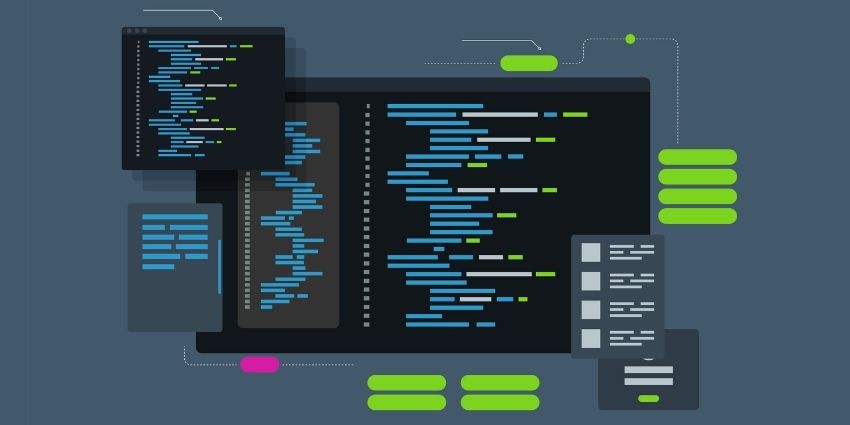Throughout history, transformative technologies have periodically reshaped the industrial landscape, each wave redefining the skills and systems that underpin value creation.
From the steam engine to electrification, from digital automation to artificial intelligence, each revolution has compressed complexity into accessible infrastructure.
Today, as AI emerges as the driving force of Industry 4.0, it is not merely enhancing how systems operate; it is reengineering the very logic of creation, especially in the domain of software development.
The Inflection Point Beckons
Within this AI-led inflection point, one profession is experiencing particularly acute scrutiny: the software developer.
The rise of intelligent code-generation tools has triggered existential anxieties in developer communities, many of which echo the uncertainties witnessed during the early days of personal computing.
Yet, the concern today is more grounded and technical. With AI models now capable of writing code, interpreting requirements, and even suggesting architectural scaffolding, the question arises with renewed urgency: Is there still a compelling need to learn how to code?
This question is not philosophical, it’s architectural.
It stems from visible shifts in software toolchains, organizational workflows, and platform ecosystems. Technologies once confined to research labs, large language models (LLMs), retrieval-augmented generation (RAG), and generative agents are now deeply embedded into IDEs, DevOps pipelines, and intelligent CI/CD orchestrators.
These models parse natural language, generate full-stack application templates, and even perform testing simulations. In such a world, learning to code is no longer about typing syntax, it is about understanding the very framework of logic that governs intelligent systems.
The Changing Topography of Software Development
Software engineering has long operated within deterministic boundaries: developers wrote explicit instructions in domain-specific languages, followed structured paradigms for testing and deployment, and maintained a clear separation between design and implementation.
This paradigm, however, is being rapidly redefined by AI-augmented development platforms.
| Criteria | GitHub Copilot X | Amazon CodeWhisperer | OpenAI Codex |
| Foundation Model | GPT-4 (Via OpenAI) | Fine Tuned Proprietary Model (On Code T5 and AWS specific corpora) | Codex (GPT-3.5 variant, evolved into GPT-4 Turbo) |
| Integration Depth | Deep Integration with GitHub Ecosystem (PRs, issues, commits, Copilot Chat in IDE, Docs, CLI) | Tight AWS IDE Plugin (Cloud 9, VS Code); emphasis on auto-generating AWS service integrations | API-based access, integration requires custom DevOps orchestration or toolchain embedding |
| Ecosystem Lock-in | Microsoft Centric: GitHub, VS Code, Azure DevOps | AWS centric: tailored for IAM, Lambda, Dynamo DB, S3 workflows | Agnostic by Design but limited UX unless embedded into custom tools |
| Language Support | Strong Support for JS/TS, Python, Go, C#, Java Weaker in niche or academic languages |
Good Breadth across enterprise languages (Java, Python, Go, JS, C#) Optimized for AWS SDK tasks |
Broadest Support comprising non-mainstream languages and shell scripting |
| Prompt Understanding | High Contextual Fluency, Supports multistep instructions, maintains conversational context | Moderate Understanding, focused on command level completions over architectural reasoning | Strong reasoning with loose memory, good for ideation and translation but lacks session persistence |
| Code Cognition | Refactors based on historical commits, supports cross-file navigation and test generation | Good at pattern matching for AWS SDK usage, lacks high-level architectural synthesis | High Generative capability but lacks codebase awareness and file context unless externally linked |
| Security Awareness | Minimal built-in security auditing, relies on GitHub Advanced Security as a separate layer | Inline vulnerability detection, flags hardcoded credentials, insecure API usage in real time | No buil-in security layer, security is developer’s responsibility |
| Use Case Analysis | Productivity-focused workflows, pair programming, documentation automation, developer ergonomics | Ideal for cloud-native teams deeply embedded in AWS, excels at IaC and backend scaffolding | Suitable for AI-powered platforms, multi-language code generation, translation, rapid prototyping |
| Weakness | Tight dependency on GitHub stack, no persistent memory across sessions, not stack-agnostic | Shallow reasoning depth, heavily AWS-bound, underwhelming outside cloud contexts | Lacks integration Polish, memory, or guardrails, requires orchestration to become usable in workflows |
| Enterprise Readiness | Moderate, better fit for individual developers or small teams unless coupled with GitHub Enterprise | High, Integrated with IAM policies, audit logging and AWS org policies for governance | Low to Moderate, needs custom wrappers for governance, logging, and multi-user deployment |
| Best Fit For | Developers working in GitHub Ecosystem, start-ups and mid-sized organizations | AWS-centric enterprise developer teams, backend/cloud engineers | AI Tool creators, teams building custom LLM workflows into their SDLC |
| What it’s not good for | Not Suitable for polyglot or multi-cloud teams, lacks depth in architectural reasoning and security | Poor fit for non-AWS environments, lacks general purpose code intelligence | Not suitable for out-of-the-box use in enterprise teams, no built-in collaboration, memory or policy controls |
Source: QKS Group
Modern AI tools like GitHub Copilot X, Amazon CodeWhisperer, and OpenAI Codex are no longer autocomplete extensions, they act as reasoning agents. Trained on vast corpora from repositories, forums, and documentation, these models understand not just code syntax but contextual intent.
They can refactor legacy systems, generate infrastructure templates, write unit tests, and optimize algorithms, all through semantic interpretation rather than syntactic matching.
This means AI doesn’t just write code; it constructs logic from abstraction, transforming prompts into actionable implementations.
Moreover, architectures such as RAG enable these models to retrieve domain-specific knowledge during inference, embedding contextual awareness directly into the development process. Combined with Infrastructure-as-Code (IaC), service mesh integrations, and cloud-native orchestration layers, AI can now traverse the entire application lifecycle, from design to runtime observability.
The traditional boundary between software ideation and execution is fading, prompting many to ask: In an environment where the machine can implement intent, does the human still need to master the mechanics of code?
From Coder to Cognitive Engineer: The Evolution of the Role
The fear of obsolescence among developers stems from a surface-level interpretation of automation, confusing code generation with system design. While AI can produce functioning components, it does not interpret business risk, reason about trade-offs, or architect solutions under multidimensional constraints.
Today’s software environments include distributed microservices, hybrid infrastructure, and regulated domains. Developers are not just writing code; they are designing systems that meet uptime guarantees, comply with data residency policies, and manage resource constraints under real-world load. AI tools can assist in these tasks, but they cannot replace the judgment required to make decisions within them.
For instance, selecting between serverless and containerized deployments is not just a performance decision, it involves cost modelling, availability zones, developer skill profiles, and integration latency. Similarly, choosing between GraphQL federation and RESTful microservices affects caching strategies, payload efficiency, and observability overheads. These decisions demand architectural fluency, something AI cannot provide in isolation.
The role of the developer is not being diminished; it’s being elevated. Coders are evolving into cognitive engineers who guide, govern, and constrain AI output. Their focus is shifting from writing functions to reasoning about systems, from syntax mastery to systemic oversight. In this model, learning to code is not about keystrokes but about acquiring the intellectual scaffolding that enables intelligent supervision.
False Binary: AI vs. Coding
One of the most misleading narratives surrounding the AI era is the dichotomy between coding and AI, as if mastering one precludes the relevance of the other. In reality, they are converging disciplines. AI literacy without coding fundamentals is operationally hollow; coding expertise without AI awareness is strategically limiting.
AI models are probabilistic by nature. They operate on inference, not certainty. This introduces risks, hallucinations, logic drift, and misaligned outputs, which developers must recognize and correct. Without an understanding of algorithmic complexity, memory models, or control structures, developers are ill-equipped to assess the correctness or efficiency of AI-generated code.
Conversely, to integrate and optimize AI within modern applications, developers must understand model internals, tokenization, positional encodings, transformer attention mechanisms, vector embeddings, and inference-tuning strategies. Understanding tools like SHAP, LIME, or RAG isn’t optional for tomorrow’s engineers; it’s essential for those building explainable, secure, and robust intelligent systems.
The future does not belong to coders or AI specialists. It belongs to professionals who can synthesize both perspectives, and reasoning through algorithms while supervising probabilistic behaviour.
AI-Augmented Development Demands AI-Literate Engineers
In the current era, development is no longer deterministic and static; it is adaptive, probabilistic, and distributed. Applications increasingly include components whose behaviour is influenced by AI models, changing based on context, user input, or external data sources. This reality fundamentally alters how we think about testing, validation, deployment, and governance.
Developers must now embed observability into model pipelines, monitor prompt-response behaviours, and build feedback loops using platforms like Langfuse, MLflow, or Evidently. Every AI interaction, each prompt token, and each vector lookup introduces a new telemetry signal. Managing this requires a mental shift: from controlling static systems to supervising evolving ones.
Security, too, takes on new dimensions. Prompt injections, data exfiltration via model outputs, or unauthorized model drift are no longer theoretical risks, and they are active threat vectors. Developers must define sandbox environments, enforce access policies at the inference layer, and establish fallback strategies when models degrade or hallucinate.
AI is not replacing development; it is reframing it. To succeed in this environment, developers must become AI-literate engineers, capable not only of using AI tools but of embedding them safely, predictably, and effectively into production ecosystems.
Implications for Aspiring Developers and the Future of Engineering Education
For those entering the profession, the message is not to abandon code, and it is to learn it with context. The traditional educational approach, focused on syntax memorization and language-specific tasks, must evolve. Foundational programming is still essential, not because it teaches one how to write code, but because it cultivates an understanding of abstraction, modularity, logic, and control flow principles that remain critical even in AI-augmented development.
Educational institutions and bootcamps must expand their scope to include system design, API governance, cloud-native infrastructure, and AI integration frameworks. Learning tools like LangChain, Transformers, or vector databases should sit alongside modules on design patterns, scalability models, and observability design. Developers must understand not just what code does, but why systems behave the way they do under AI supervision.
In addition, developers must engage with open-source AI governance, contribute to model transparency initiatives, and actively shape how explainability and fairness are embedded in tools. The next era of software development will not be defined by closed, monolithic stacks, it will be federated, modular, and subject to socio-technical accountability. Those who combine deep technical knowledge with a systemic and ethical lens will lead this evolution.
Conclusion: Coding Is the Foundation, Not the Destination
To question the relevance of coding in the AI era is to misread the trajectory of software’s evolution. Code is no longer the sole output of development; it is the foundational layer that enables the design, supervision, and adaptation of intelligent systems. AI will not eliminate the developer’s role; it will eliminate redundancy, amplify cognitive bandwidth, and demand higher-order reasoning.
The future belongs to developers who think in both logic and language models, architect systems with resilience and adaptability, and understand that writing code is not an end; it’s a way of structuring knowledge. AI may write the lines, but only developers can define the logic, govern the systems, and ensure that what is built remains reliable, ethical, and human-centric.
Yes, learn to code. But learn it as a language of reasoning, not as a vocational task. Because while AI can generate syntax, only you can architect systems that endure.








